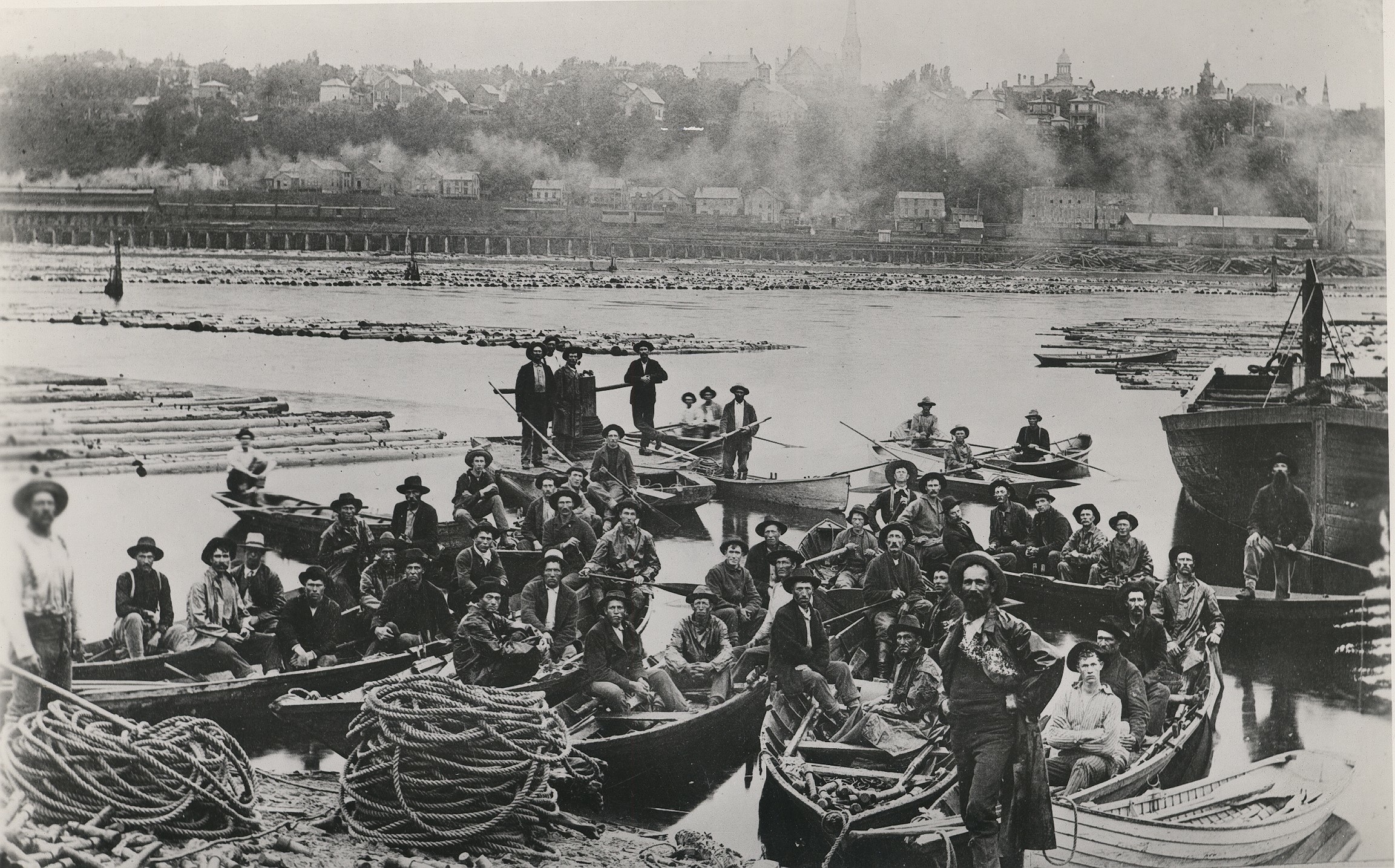This issue: Contents
Tuesday, January 12, 2016
- Editor’s Note
- WCHS News: Winter Ice Cream Social
- What Is This Thing?!
- Old News: Lumbering Moves North
- Featured Article: “Dancing With A Crowd of Swedes”
Woah, woah, woah. What happened to our mild winter!? I was really enjoying those 30 and 40 degree days back in December…I suppose kicking off the New Year in the single digits is just about as Minnesotan as you can get.
The only thing more Minnesotan than enduring Arctic-esque blasts is to have an ice cream cone in them! Our annual Winter Ice Cream Social is this Saturday! Head down to our News section to get the scoop.
I’ve got another mystery item from WCHS’ extensive artifact collection eagerly awaiting your attempts at identification down in today’s “What Is This Thing?!”
Although the lumber industry was the catalyst that birthed Stillwater and the surrounding communities, the supply of natural timber couldn’t survive the onslaught of industry. By the turn of the 20th century, fresh lumber in the St. Croix Valley was hard to come by. In this issue’s Old News, you’ll read a little about the fate of some of Stillwater’s now unnecessary lumbermen.
And staying on the topic of lumbering, we’ll read a letter from one of these lumber camps from way back in 1873. And just as a note, this letter was written from January 26th to the 30th. That’s right, winter was the season when the men were actually out in the woods felling trees.
The lumberjack writing the letter makes mention that his birthday fell on January 28th. According to the Stillwater Messenger covering that week, January 28th, 1873 “seemed to be one of the coldest days of the season, though the mercury in our reporter’s thermometer only indicated 26 degrees below. We heard reports as low as 38 degrees, but they were probably incorrect.”
It was 26 degrees below zero on this guy’s birthday and he didn’t even mention how cold it was!
Frank Briggs was outside swinging an axe in this kind of weather and I barely want to run from my apartment to my car…they were a hearty stock back then.
Want to learn more about the history of Washington County? “Like” WCHS on Facebook and follow us on Twitter!
Sean Pallas
Historical Messenger editor and Warden’s House Site Manager
spallas.wchs@gmail.com
WCHS News
Winter Ice Cream Social
Are you going to let a little bit of snow and freezing temperatures keep you indoors?! Of course not! We’re Minnesotans!
January is the perfect time for an Ice Cream Social!
Join WCHS this Saturday, January 16th from Noon – 4:00 PM for everyone’s favorite seasonally-inappropriate winter event!
With FREE ice cream from Leo’s Malt Shop, you won’t even notice those cold gusts of wind off the river! Head over to North Lowell Park in Stillwater, don your warmest winter wear, grab your ice skates, and join us in helping continue this fun (but admittedly a bit silly) Stillwater tradition!
Coffee will also be provided & chili will be available for a nominal fee.
What is This Thing?!

What Is This Thing?! (Round 25)
So most folks were able to tell that last issue’s What Is This Thing?! was a case that held binoculars…but a few were even able to tell that these are specifically Opera Glasses!
Stillwater used to actually have it’s very own Grand Opera House!
In 1888, author W.H.C. Folsom described it in his Fifty Years in the Northwest as follows: “The opera house occupies the site of the old Lake house, on Main street between Nelson and Chestnut streets. It was commenced in 1880 and finished in 1881, under the supervision of L.W. Eldred, architect. Its size is 90 x 120 feet, ground plan, and four stories in height, or seventy-one feet from lower floor to cornice. The style of architecture is a blending of the Queen Anne, Victoria and Gothic. The entrance to the upper part of the building is a stairway twelve feet wide, in a lofty, ornamental turret. The auditorium is 64×120 feet, and beautifully and elaborately finished and furnished, and is capable of seating over 1,200 persons. It is well lighted, being supplied with 130 gas jets, warmed by steam, and well ventilated. The stage is 39×64 feet, complete in all its appointments, and supplied with all the necessary stage scenery, wings, border bridge, balcony, interior and other decorations. The ceiling of the auditorium is superbly frescoed and the cornice is adorned with medallions of Shakespeare, Haydn, Schiller, Goethe, Dickens, Handel, Scott, Longfellow, Mozart, Tennyson, and Beethoven. The parts of the building not occupied for stage purposes are apportioned to halls, offices and stores.”
Over the years, the Grand Opera House hosted a plethora of amusements, including everything from plays, operas, and masquerades, to boxing exhibitions, the John Phillip Sousa Band, and even Buffalo Bill’s Wild West Show.
The opera house was unfortunately destroyed by fire in 1902 and never rebuilt.
Thanks to everyone who took a guess at last week’s item!
Can you identify the WCHS artifact photographed above? Can you guess its use? If you’d care to venture an answer, you can send an email to me at spallas.wchs@gmail.com, tweet @WCHSMN, or post your guess on our Facebook page.
Good luck!
Full Image
Old News
Lumbering Moves North
Since Stillwater’s population was first officially counted in the 1860 Census, every decade had seen an increase in population. However, 1910 marked the beginning of a new trend.
Over the next few decades, Stillwater would lose about half of it’s “Golden Era of Lumber” population shrinking from almost 13,000 in 1900 to around 7,000 in 1940. Without the raw trees to support the industry, the lumbermen and many other workers were suddenly out of a job – and they didn’t stick around.
But where did they go? Well, naturally they followed the trees; specifically, into Canada.
One of the most interesting elements of this article is that the editor apparently understood that over-harvesting had completely destroyed the St. Croix Valley’s timber resources – but makes no mention or comment that the process was seemingly being repeated by the same men in the Great Saskatchewan Valley.
On a slightly less depressing of a note, the other bit of this article that jumped out at me is the very familiar name of one of the lumbermen…
Old Timers in the Far North – Stillwater Messenger – January 12, 1907
Dan Elliot, who is working for the Prince Albert Lumber Company, writes an interesting letter to the Gazette of the out look in that far away lumber district. Prince Albert is the capitol of Saskatchewan, and is located about 800 miles northwest of Winnipeg, on the Canadian Northern railroad. It contains about 10,000 inhabitants and is a thriving little city. In the three camps of the Prince Albert Lumber Company are a number of Stillwater men who have employment. Such well known loggers as Jas. R. Brennan, Jerry Donovan, Dick Carrigan, Dave Heffron, Ronald McDonald, Tom Ruseel, Tom Wadden, Arthur Farnham, Norman Russel and others, who have nearly depleted the forests of the St. Croix, are repeating the act in the Great Saskatchewan valley. The weather in that region is favorable to logging interests and a vast territory is being worked over by numerous companies that are engaged in cutting tress and getting ready to manufacture the logs into lumber and to ship the product east, west and south, and a great deal of it finds a market north, clear to Hudson Bay.
Featured Article
“Dancing With A Crowd of Swedes”
Frog Creek. Jan. the 26th, 1873
Respected Friend
Being it is Sunday morning and I have nothing else to do, I will improve my time in writing to you. I am well as [can be], hope this will find you the same. There is no one drunk to day, there were six of them the other night. I had most a fearful time. They went off and had a dance to another camp. They kept me up til twelve o’clock at night writing to you and [illegible]. One wanted one thing and one wanted another. Got my socks, moccasins, jacket in the morning. I hadn’t clothes enough to put on. We have quite a decent crew when they are sober. There is six Swedes in camp, three Frenchmen, nine Irishmen, four Americans, one Englishman. Quite a mixture don’t you think so? Our cook is Swede, he gives us good grub. Have lots of cranberries, Apples, everything that is good. 
I don’t know what I wrote to you the other night – not half, I couldn’t think of anything [when] them lads more than went for me…Anderson did not say anything about them cranberries nor I to him. They were too busy a dancing. Don’t you think I was in big business dancing with a crowd of Swedes. Winnie and I danced one set. Got Bill Soule dancing with a nice young ladie and then made him call off. It was better than any circus I ever went to. I went to bed at ten o’clock, went to sleep about three in the morning – all the noise you ever heard…but then all would dance a while then drink a while. When I got to sleep I had to get up and feed the horses.
Well I will change the subject a little. The cook says he must have the table for it is dinner time. So I am obliged to stop for awhile. Well Cass I will try to finish this sheet. Today is the 30th, my birthday was day before yesterday. Wouldn’t you like to [have] pulled my ears? The supply team comes tonight. I will send this down tomorrow. I don’t know but I shall [buy] another horse. Old Tom is not extra well. The teams here are all getting por. Wm. Soule came very near his last-end. He was loading a log had a rope fast to a tree. He started his team and pulled the tree over onto his head. He hadn’t his senses for awhile, he is better tonight.
I have got a great little partner. He tends shed for me. He is French, lives in Little Canada. It is getting late so I will c lose hoping to hear from you soon. Give my respects to all the folks and a share to yourself.
From your friend,
Frank Briggs
I will give you Directions not knowing if you got my other letter.
Frank Briggs
Rush City, Minn.
Harrigan & Sullivan Camp


